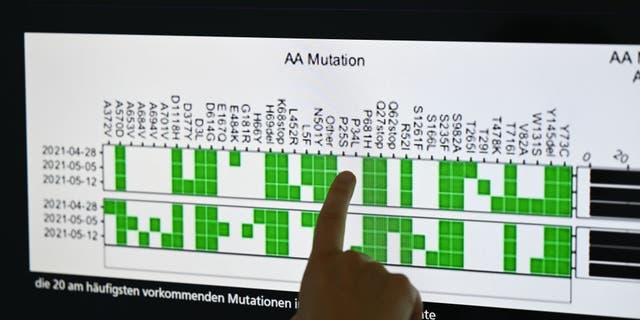Uptick in Covid virus cases detected in wastewater sample sites: CDC

health Eshrag:
NEWYou can now listen to Fox News articles!
COVID-19 virus detected in wastewater sampling sites is on the rise, according Centers for Disease Control and Prevention (CDC) data. The trend comes as the country recently began lifting mask mandates and easing pandemic restrictions aimed at stopping the spread of the coronavirus.
Of the 398 current wastewater sampling sites with active data, 44 sites saw an increase of 1000% or more in detection of SARS-CoV-2 RNA wastewater levels and 62 sites saw a 100% to 999% percent increase, during the period of Feb 26, 2022 – Mar 12, 2022, according to the CDC COVID data tracker.
Chart showing a 15-day percent change in SARS-CoV-2 levels in wastewater across the United States from February 26 – March 12. Data courtesy of the Center for Disease Control and Prevention.
REPUBLICANS GO FOR KILL SHOT ON COVID TRANSPORTATION MASK MANDATES: ‘ABOUT TIME’
Dr. Aaron Glatt, who serves as the Chief of Infectious Diseases and is an epidemiologist at Mount Sinai South Nassau on Long Island, New York, told Fox News one reason for the uptick could be due to a coronavirus variant. “We definitely are seeing an increase across our region, across our country, and indeed across the world, of the BA.2 omicron variant.”
Glatt who is also the Chair of the Department of Medicine and a spokesperson for the Infectious Diseases Society of America also told Fox News, “This probably explains the uptick of cases and the presence of higher values in the wastewater. Whether it presages more cases and hospitalizations in the near future – we will find out in a week or two.”
Glatt also noted, “We do believe that this strain is more contagious albeit it is not causing more severe illness.”
OMICRON BA.2 SUB-VARIANT SPREADING IN NEW YORK CITY
The CDC confirmed Tuesday, the increased detection of the coronavirus in sewage surveillance systems, after a recent report in Bloomberg stated that more than a third of the CDC’s wastewater sample sites across the U.S. showed rising Covid-19 trends during the time frame from March 1 to March 10.

A sample analysis of a wastewater sample with evidence of viral genes of the SARS-CoV-2 virus can be seen on a monitor in a laboratory at the Institute of Hygiene and Health on March 3, 2022 in Hamburg, Germany. In a model project, the concentration of SARS-CoV-2 is to be monitored in wastewater over a period of one year.
(Photo by Daniel Reinhardt/picture alliance via Getty Images)
Although health officials have said the number of reported cases of COVID-19 have remained at a recent low, the number of sewage surveillance sites with rising Covid-19 cases nearly doubled from what it was during the Feb. 1 to Feb. 10 period, when the highly contagious omicron variant began to wane, according to the media report.
During the period of March 1 to March 10, more than one-third (36%) of the sites saw an increase in detection of the virus, which was more than twice the number of wastewater sample sites (15%) that were seeing a rise from Feb. 1 to Feb. 10, according to the Bloomberg analysis.
Amy Kirby, who is the program lead for the National Wastewater Surveillance System (NWSS) at CDC, acknowledged to the media outlet that although there is an uptick in sites seeing an increase, the wastewater levels are generally very low. Kirby said in a statement to the media outlet, “These bumps may simply reflect minor increase from very low levels to still low levels.”
PFIZER-BIONTECH SEEK AUTHORIZATION FOR SECOND COVID-19 BOOSTER
Kirby was also quoted as saying, “Some communities though may be starting to see an increase in Covid-19 infections, as preventions strategies in many states have changed in recent weeks.”

In wastewater, the development of the coronavirus pandemic can be reliably predicted. TU Darmstadt, a public German university, is one of only two reference laboratories for the sequencing of wastewater samples in Europe, analyzing samples from about 50 wastewater treatment plants from all over Europe and coordinates the two Hessian pilot projects in Frankfurt and Wiesbaden.
(Photo by Arne Dedert/picture alliance via Getty Images)
According to the CDC, a person infected with SARS-CoV-2 can shed viral RNA, the genetic material from the virus, in their feces. This RNA can be detected in community wastewater, which includes water from household or building use such as showers, sinks and toilets that can contain human fecal waste. It also collects water from rain and industrial use. The wastewater is collected from a treatment plan and samples are tested for the virus. The data is reported by health departments to the CDC, the federal health agency explained on its website.
CLICK HERE TO GET THE FOX NEWS APP
The NWSS DCIPHER system analyzes the data and reports results to the health department for use in their COVID-19 response. The results are available to the public through CDC’s COVID Data Tracker.
Health officials told Fox News said this type of wastewater surveillance could be an early indicator if the number of individuals with COVID-19 in a community is increasing or decreasing.
Noting that the news was copied from another site and all rights reserved to the original source.
xnxx,
xvideos,
porn,
porn,
xnxx,
Phim sex,
mp3 download,
sex 4K,
Straka Pga,
gay teen porn,
Hentai haven,
free Hentai,
xnxx,
xvideos,
porn,
porn,
xnxx,
Phim sex,
mp3 download,
sex 4K,
Straka Pga,
gay teen porn,
Hentai haven,
free Hentai,


